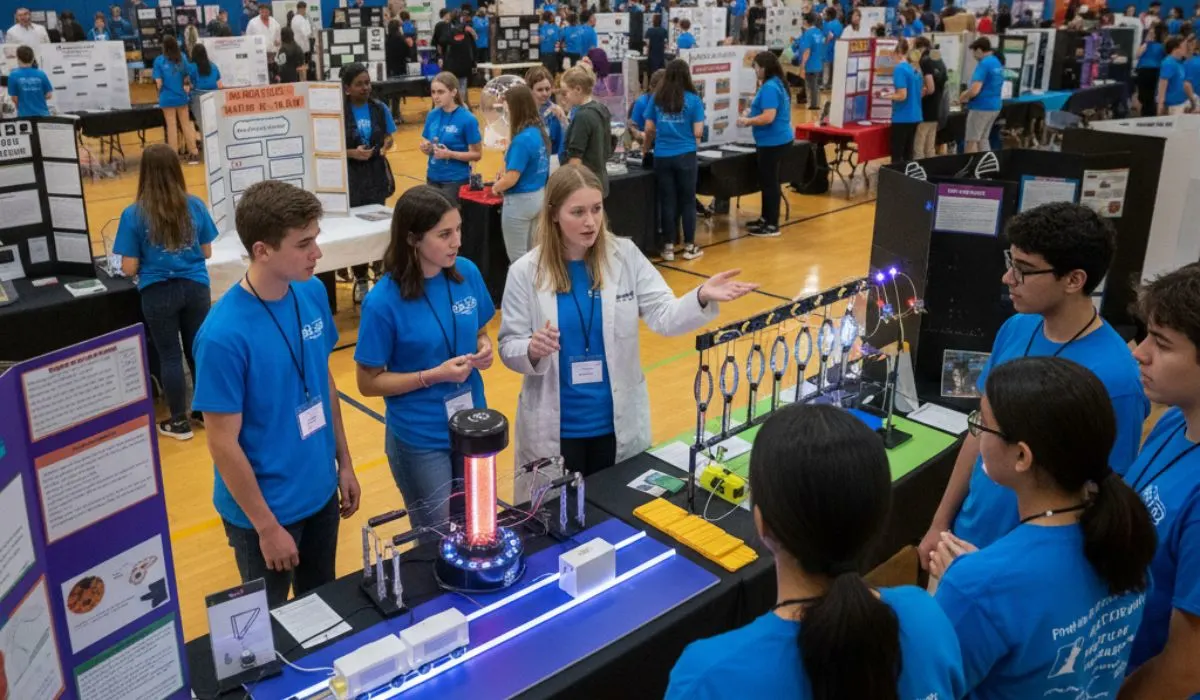Science fairs are one of the best ways for understudies to investigate their interest and imagination through viable learning. Among all subjects, material science stands out as one of the most intriguing and thought-provoking sciences. It makes a difference when understudies get how the universe works—from movement and vitality to light and sound. Choosing innovative physics experiments for science fairs not onlycaptures the audience’s consideration but also reflects a profound understanding of logical concepts in a fun, locked-in way.
In 2025, the emphasis on STEM-based learning continues to develop, making material science tests more intuitive, inventive, and imaginative than ever recently. Let’s investigate how you can make your following science reasonably extend and really stand out.
1. Significance of Advancement in Material Science Projects
Traditional tests like pendulum movement or Newton’s laws are incredible for apprentices, but to genuinely inspire judges and gatherings of people, advancement is key. An inventive material science exploration combines center material science standards with imagination, advanced innovation, or real-world applications.
Innovation might be cruel coordination sensors, utilizing AI-based recreations, or investigating natural applications of material science. For example, building a scaled-down wind turbine show to illustrate vitality transformation or an attractive levitation framework can appear to have both conceptual clarity and imaginative execution.
By applying ordinary concepts in an unused way, understudies can bridge the crevice between hypothetical information and real-world utilization—which is precisely what science fairs are outlined to celebrate.
2. Criteria for Incredible Science Reasonable Material Science Project
Before jumping into trying thoughts, it’s fundamental to get what makes an extent effective. An extraordinary science reasonable extension should:
- Demonstrate clear logical principles
- Encourage hands-on participation
- Be outwardly locked in and interactive
- Offer a real-world application
- Show inventiveness and originality
Projects that mix material science with innovation, maintainability, or building frequently score higher. Utilizing sensors, sun-based boards, or basic coding can donate your venture a present-day edge and illustrate cross-disciplinary learning.
3. Inventive Material Science Tests You Can Try
Here are a few inventive material science tests that are perfect for school or college science fairs. Each combines interest, common sense, and logical depth.
a. Attractive Levitation Prepare Model
Demonstrate how attractive areas can cause objects to drift. Utilizing solid neodymium magnets and a basic wooden base, you can make a smaller-than-expected maglev that shows how attractive shock permits frictionless movement—the same guideline behind Japan’s high-speed trains.
- Physics Concept: Attractive drive, levitation, and electromagnetism.
- Innovation Tip: Include movement sensors or driven lights to make the show more interactive.
b. Custom-made Cloud Chamber for Molecule Tracking
A cloud chamber lets you visualize the way of subatomic particles like alpha or beta beams. Utilizing dry ice, isopropyl alcohol, and a fixed holder, understudies can make a secure and utilitarian demonstration that appears in the undetectable world of radiation.
- Physics Concept: Molecule movement and ionization.
- Innovation Tip: Utilize smartphone cameras to record the molecule trails and analyze development digitally.
c. Remote Vitality Exchange Experiment
Wireless charging is common nowadays, but you can reproduce it utilizing copper coils and a control source. Construct a little show illustrating inductive coupling, where vitality exchanges from one coil to another through an attractive field.
- Physics Concept: Electromagnetic acceptance and vitality transfer.
- Innovation Tip: Test vitality misfortune at diverse separations and points to consider efficiency.
d. Solar-Powered Stirling Engine
Combine thermodynamics and renewable vitality by developing a solar-powered Stirling motor. Utilizing ordinary materials like syringes, inflatables, and mirrors, you can illustrate how temperature contrasts make motion.
- Physics Concept: Warm vitality transformation and thermodynamics.
- Innovation Tip: Coordinated sun-based reflectors to boost productivity and degree control output.
e. The Acoustic Levitation Experiment
Use ultrasonic sound waves to suspend little particles like Styrofoam balls. It’s an outwardly captivating extent that grandstands how sound weight can make steady hubs where objects hover.
- Physics Concept: Wave impedances and sound pressure.
- Innovation Tip: Explore with distinctive frequencies to discover the most steady levitation point.
Read Also:- Quantum Machine Learning Is Transforming Physics Research
4. How to Display Your Material Science Exploration Effectively
Even the most inventive text won’t sparkle without a great introduction. To awe science, reasonable judges center on clarity, visual offer, and clarification. Here’s how:
- Start with a clear theory: What are you testing or demonstrating?
- Show your setup step-by-step: Utilize charts, graphs, or live demonstrations.
- Explain the material science: Keep it straightforward but accurate.
- Add real-world pertinence: Clarify how your concept is utilized in businesses or day-to-day life.
- Engage your group of onlookers: Empower them to connect or ask questions.
A proficient introduction with labeled models, blurbs, or indeed brief recordings can offer assistance to stand out among handfuls of others.
5. Coordination, Innovation, and Physics
Today’s science fairs are not fair; almost all hypotheses are about advancement. Consolidating innovation such as Arduino sheets, Raspberry Pi, or sensors can take your exploration to the following level.
For the occasion, you could:
- Use a movement sensor to analyze pendulum swings.
- Integrate information logging to degree voltage or acceleration.
- Create an app that visualizes vitality exchange in genuine time.
Combining coding and material science empowers problem-solving and makes your venture future-ready.
6. Security and Supportability in Experiments
While testing, security ought to continuously be a beat need. Continuously utilize protected materials, maintain a strategic distance from high voltages, and wear defensive adaptations when necessary.
Also, attempt to make your venture eco-friendly by reusing materials or illustrating feasible vitality concepts—like sun-based, wind, or water control. A venture that equalizes science, development, and maintainability will awe both instructors and judges.
7. Why Imaginative Material Science Ventures Matter
Choosing innovative physics experiments for science fairs does more than offer assistance if you win competitions. It builds basic thinking, inventiveness, and problem-solving abilities—fundamental characteristics for future researchers and engineers.
Moreover, testing with advanced concepts like remote control or renewable vitality presents understudies to real-world applications of material science, preparing them for careers in STEM fields.
In brief, imaginative ventures support interest, motivate imagination, and show how material science shapes our ordinary lives—from smartphones to satellites.
Read More:- Fundamental Physics Concepts Explained: A Beginners Guide
Conclusion
Physics is not fair to most equations or conditions—it’s approximately understanding the standards that administer our universe. Science fairs give the culminating stage to change that understanding into inventiveness. By investigating innovative physics experiments for science fairs, understudies can lock in with real-world issues, test modern thoughts, and motivate others through their discoveries.
So, whether you construct a suspending preparer, a molecule tracker, or a solar-powered motor, keep in mind—advancement starts with interest. The more you investigate, the more intriguing material science gets to be.

